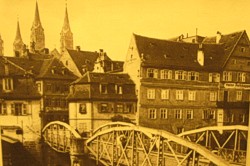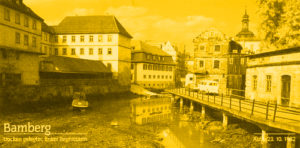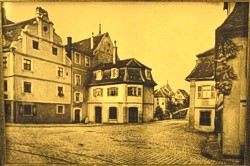ANNO DOMINI 1314
marks the very first time that the name Brudermühle received official mention – this in a letter written by Otto, Cathedral Provost of Bamberg.
In 1347, Friedrich Zollner was recorded as being the first layperson commissioned by the Cathedral Chapter to operate the Brudermühle.
 Apparently much older than these early entries, however, is the mill itself (Brudermühle roughly translates as “Mill of the Brotherhood”). It was most certainly a part of Bamberg’s oldest milling complex, which was so vitally important for the Castle of the Babenbergs that occupied what is now the Cathedral Square, and also for the very first town centre that was located below the Castle. In the year 896, the Castle and mill were owned by Count Adalbert of Babenberg and his brothers. In 906, the Holy Roman Empire confiscated the properties of the Babenbergs, transferring ownership of the Castle and its associated land in 975 to the Bavarian Duke Henry the Quarrelsome. His son and heir, Emperor Henry II, then gave these as a wedding present to his bride, Kunigunde of Luxembourg, in 977. When by 1007 Henry’s union with Kunigunde had failed to produce any children, the Emperor decided to present the entire “Royal Estate” as a gift to the newly founded Diocese of Bamberg. As a result, the Brudermühle fell under the lordship of the Cathedral Chapter. This state of affairs lasted for centuries: For example, it is recorded that in 1406 the Brudermühle paid “tribute” to the Cathedral Chapter of 76 sacks of wheat flour.
Apparently much older than these early entries, however, is the mill itself (Brudermühle roughly translates as “Mill of the Brotherhood”). It was most certainly a part of Bamberg’s oldest milling complex, which was so vitally important for the Castle of the Babenbergs that occupied what is now the Cathedral Square, and also for the very first town centre that was located below the Castle. In the year 896, the Castle and mill were owned by Count Adalbert of Babenberg and his brothers. In 906, the Holy Roman Empire confiscated the properties of the Babenbergs, transferring ownership of the Castle and its associated land in 975 to the Bavarian Duke Henry the Quarrelsome. His son and heir, Emperor Henry II, then gave these as a wedding present to his bride, Kunigunde of Luxembourg, in 977. When by 1007 Henry’s union with Kunigunde had failed to produce any children, the Emperor decided to present the entire “Royal Estate” as a gift to the newly founded Diocese of Bamberg. As a result, the Brudermühle fell under the lordship of the Cathedral Chapter. This state of affairs lasted for centuries: For example, it is recorded that in 1406 the Brudermühle paid “tribute” to the Cathedral Chapter of 76 sacks of wheat flour.
This relationship of dependence on the church may explain the origins of the name Brudermühle, which might have had something to do with the Georgsbruderschaft (Brothers of St. George) of the Cathedral Chapter. Another possible explanation involves the location of the mill between the River Regnitz and the Franziskaner (Barfüsser) Kloster (monastery) – which was founded in 1311. Indeed, documents from that time and later refer to a Mühle bei den Barfüßern, a Mühle bei den Brüdern, and an Untere Brudermühle.

The Brudermühle was subject to changing fates throughout the following centuries. Millers were repeatedly compelled to take measures for the maintenance and upkeep of the building complex, while at the same time struggling to obtain water and fishing rights. On four occasions – in 1478, 1506, 1667, and 1762 – the mill, much of it made of wood, burned completely to the ground.
Reconstruction efforts were not always quite successful, however: In the period around 1620, the mill was in such a “ruined” state that it was condemned and deemed useless.
Sometime after 1621, the mill was taken over by a certain Hans Rehe, who restored it and successfully resumed its milling operations.
The building as it stands today was constructed after the fire of 1762. Its corner facade still bears the magnificent Madonna statue that was installed at that time, and which is believed to have been built in the workshop of the sculptor Leonhard Gollwitzer.
The Brudermühle continued to be used as a flour mill until the mid-nineteenth century.
 In 1888, the City of Bamberg assumed ownership of the building, installing its first waterworks at the site and later using the mill’s water wheels to generate electricity. The waterworks were shut down in 1922, to be replaced by a municipal repair and calibration facility for electricity meters. In 1976, Toni Schenk and Sophia and Wolfram Zachert purchased the Brudermühle, completely restoring the honourable old house in accordance with Germany’s strict codes for the preservation of historical buildings.
In 1888, the City of Bamberg assumed ownership of the building, installing its first waterworks at the site and later using the mill’s water wheels to generate electricity. The waterworks were shut down in 1922, to be replaced by a municipal repair and calibration facility for electricity meters. In 1976, Toni Schenk and Sophia and Wolfram Zachert purchased the Brudermühle, completely restoring the honourable old house in accordance with Germany’s strict codes for the preservation of historical buildings.
The new owners transformed the interior into a wine tavern and hotel with a typical Franconian flair.
On 30th May 1980, the new Brüdermühle’s first guests, who arrived from the Bamberg partner cities of Villach and Rodenz, were welcomed by Erna and Georg Vogler. However, it wasn’t until 17th October 1980 that the restored building was presented and opened to the public. Since that time, the Vogler family have harmoniously combined in the Brudermühle the best of Bamberg tradition with the convenience and comfort one expects of a modern hotel and restaurant.
